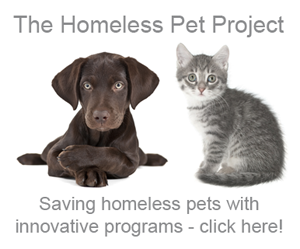23 October 2013
In animal rescue, you’ll find some of the biggest hearts and most compassionate people you could ever hope to meet. But sadly, there is also way too much drama and unfounded attacks that continually rip through the community. I especially see it whenever the no kill discussion comes up. Since launching Pawsitively Texas in late 2008, I’ve been able to observe the animal welfare community and have been repeatedly heartbroken, yet consistently inspired.
I’ve been inspired by the people who, bottom-line, believe killing animals is wrong and work to implement proven and innovative solutions to save them. I’m deeply saddened by the people who oppose no kill because they do not understand it and spend their time tearing it down vs. actually implementing the programs that work.
It’s very easy to be overwhelmed and to buy into the lie that there is nothing that can be done but to “humanely” kill the animals. But it’s just that, a lie. This is the reason I believe that …
Until a shelter has partnered with community volunteers and implemented the 11 point no kill equation, all 11 points, they will continue to feel overwhelmed and there are no alternatives. It’s a matter of cup half full or cup half empty. A positive person seeks solutions while a negative thinking person focuses on the many problems and stalls in the mission to save the lives of shelter animals.
The no kill equation was designed by Nathan Winograd of the No Kill Advocacy Center. Many people love him for the amazing work and life-saving contributions he has made, while others dislike and attempt to discredit him for taking on the national, multi-million dollar, donor-funded animal welfare organizations. Regardless of how you may feel about Winograd the person, his programs, once properly implemented, undeniably save lives. And isn’t that our mission in animal rescue? Focus on what is important; don’t get distracted.
The 11 Point No Kill Equation by No Kill Advocacy Center
1. Feral Cat Trap-Neuter-Release (TNR) Program – feral cats in an animal shelter environment will be deemed unadoptable and killed. Feral cats who’ve been spayed/neutered and released do not contribute to a population explosion, but contribute to the eco-system; some go on to have active jobs as barn cats keeping down the unwanted mice population.
2. High-Volume, Low-Cost Spay/Neuter Program – these programs are needed in every community along with an active PR campaign to reduce the number of unwanted litters entering the animal shelter which is a sure and immediate death in so many shelters across the U.S. Some people believe this is the ONLY solution, but I believe it is a key component of an 11-point plan.
3. Rescue Groups – animal shelters need to partner with rescue groups and have a rescue and volunteer list that they email daily or weekly with available and urgent pets. Rescue groups alone can not solve the problem, but as a partner to the shelter, they can be an invaluable and powerful partner in moving pets out of the shelter environment swiftly and into a loving home.
4. Foster Care Program – increase shelter capacity (free up kennel space) by moving available pets into foster homes where they will be less likely to catch an illness or become depressed and more likely to be adopted quickly.
5. Comprehensive Adoption Program – animal shelters must market their facility as “the place” to find a pet in the community. You’ll often find that people didn’t even know their shelter exists; that’s a marketing problem. I understand many shelters are often underfunded and understaffed, that’s why the community partnership is so critical to the success of saving lives. Shelters can assemble a marketing team (professionals, college interns, etc.) that create innovative pet adoption and public relations campaigns. By utilizing the community resources as a shelter partnership, animal shelters can do so much more without requiring additional funding or staffing from the city.
6. Pet Retention – owner surrender animals often fill up a shelter. But sometimes, an owner really loves their pet and is in desperate need of help. Perhaps a landlord requires a pet deposit they can not afford. Or their pet needs medical care. Or training. A shelter program like Austin Pets Alive’s Positive Alternatives to Shelter Surrenders, is a community partnership where PASS will assist pet owners enabling them to keep their pet. And in those situations where an owner believes they have no other alternative but to give up their pet, a PASS program will assist the pet owner in finding a new home, vs. taking their pet to the shelter.
7. Medical and Behavior Programs – some animals enter the shelter system in need of medical care or with correctable behavior problems. Some animals become ill in the shelter environment and then move to the shelter kill list, vs. finding a loving home. A comprehensive vaccination, animal handling, and cleaning protocol reduces the spread of illness in a shelter. Care and rehabilitative, as well as fundraising campaigns, help an innocent animal receive the care needed to be healthy and adoptable. With the gift we have in social media, many shelter partner rescues now post a pet online and include a link to a fundraiser like petcaring.com. People see the pet, they can neither adopt or foster, but they can spare $5 and suddenly enough money has been raised to pay for the pets’ spay/neuter, vaccinations, and surgery or med care for an illness or injury. An animal rescue group can more easily bring a pet into their care if they do not have to determine if they can first raise enough funds to cover the pet’s expenses; they can pick up the pet from the animal shelter and take directly to the vet. A much more efficient and cost-effective system for saving animals.
8. Public Relations / Community Involvement – as mentioned previously, the community will often help if they only know the need and are allowed to become involved. A comprehensive PR/social media program establishes your presence in the community. A shelter is not expected to save every animal on their own manpower and budget; partner with the compassionate members of the community for a powerful, life-saving partnership. I believe every single shelter in America needs an active PR/social media team with access to the shelter population (strays, adoptables, and kill list). The “stray” team can search stray hold intake and compare to “lost pet” posts on social media and classifieds. The adoptables and kill list team can generate exposure and raise funds for pets to increase their chance at adoption.
9. Volunteers – as stated and illustrated in the previous points, volunteers are the foundation, the backbone, of a proactive animal shelter committed to saving lives. There is simply no other way to truly increase the save rate of a shelter without dedicated volunteers working in tandem with shelter staff to help the animals. They are the partners needed to implement proven and innovative programs that will save lives.
10. Proactive Redemptions – move from the passive “catch/hold/kill” method of animal sheltering into a proactive mission to help owners be reunited with their beloved pets. If a pet owner does not know a shelter even exists, they will not know to look for their pet there. As mentioned previously, have a volunteer(s) focus on the stray intake. Give them access to take photos and post online; they will then search other online posts/pages and classifieds to match lost pets with the strays sitting in the shelter missing their family.
11. A Compassionate Director – a compassionate shelter director is vitally important in a cultural change for an animal shelter. If a shelter employs a director who has little regard for animals or is just in the job for a paycheck, they have not properly staffed the shelter. In every field, employers seek the most qualified candidate; why should animal shelters be any different. The desired candidate is not only one that desires to provide animal control for the community, but one who wishes to help reunite families with lost pets, provide care for the animals in the shelter system, and partner with the community to reduce shelter intake and increase the live release rate. If the candidate does not embrace these philosophies, they are the wrong person for shelter leadership and should be redirected to a position that more closely reflects their skills and interests.
Killing as a means of animal population control is the easy way; but it’s also inhumane and immoral. Building and maintaining a no kill community takes hard work, dedication, commitment – but you don’t have to figure it out for yourself! Implement the no kill equation and build a shelter/community partnership that works.
Here are two additional articles you’ll want to read and share; in these articles, you’ll meet people who have led their community to no kill and see the obstacles they overcome to do so. Click on the blue, bold titles to read, then please share! We have the solution to save more lives, we just need to spread the word and rally local community volunteers to implement the programs with their shelter.
Click to read Building a No Kill Community – No Experience Needed
Achieving Success Despite the Obstacles – click the arrow to watch this inspiring video.
Subscribe Now: Be sure and subscribe to join the Pack and never miss an informative Pawsitively Texas blog post! Simply add your email address, then click the Subscribe Now link. Look for the yellow/orange icon in the upper right column. No worries, we’ll never spam you, you’ll only receive an email notifying you of new blog posts on Pawsitively Texas. Thank you for your support of my work for the pets!










Excellent article. I just finished reading an article that a friend wrote on the problems with homelessness in their city. Strangely the article began with a photo of a man with his dog and a sign requesting money for food. The entire article (in the West Sacramento Sun) was written without ever mentioning the dogs of the homeless. Often these dogs are very well cared for by their owners but if the owner is arrested or dies, the dog is left to wander the streets. The homeless person will usually not accept lodging if his dog is not welcome as this dog is his only friend in the world and often their only connection to reality. I especially like the section in your 11 steps that deals with community, and the section that deals with PR. That is extremely important in the DFW metroplex because there are so many places to check if your dog goes missing and there apparently is no common thread between shelters. Some of the shelters have no idea that there are any other breeds besides pit bullls and chihuahuas and once a dog is mis-labeled their chance of being found by their owner goes to nil.
Thanks Toni! All very good points. Fortunately here, there are a couple of homeless shelters that will accept pets; Samaritan Inn in McKinney is one.
THANKS FOR ALL THIS INFO.-SEVERAL YRS. BACK I HAD BUILT A LARGE ENCLOSED FENCE IN MY YARD FOR SOME FERAL CAT I WAS TRAPPING,NEUTERING, SPAYING HAVING THEM WORMED AND GIVING ALL SHOTS.I PUT THEN IN THE FENCE BECAUSE WANTED TO BE ABLE TO STOP FEEDING COLONIES BECAUSE OF MY AGE. ANYWAY AFTER 3YRS OF THESE BEAUTIFUL ANIMALS LIVING IN AND LOVING THIS SAFE ENVIRONMENT, (THEY ALSO HAD A ROOM WITH HEAT AND AIR CONDITIONING PLUS LITTER PANS). I WAS TOLD BY ACO. I HAD TO GET RID OF THEM, I SEARCHED AND SEARCHED FOR SOME WHERE TO PLACE THEM AND COULD FIND NO PLACE. MY COURT DATE WAS COMING UP SO I TOOK THEM TO MY DAUGHTERS HOUSE IN THE COUNTRY SHE WAS FEEDING AND TAKING CARE OF THEM, THEN THEY STARTED DISAPPEARING AND ONE NIGHT MY SON-IN-LAW SAW 3 COYOTES TEARING ONE CAT APART. IT JUST BROKE MY HEART—- WE ARE NOW HAVING A TRIAL TRAP/NEUTER/SPAY AND RETURN IN WEST COLUMBIA IT WILL END NEXT OCTOBER. AS OF NOW WE CAN FEED COLONIES, ANIMAL CONTROL WILL TRAP FERAL CATS FOR YOU THEN RETURN THEM TO WHERE THEY CAME FROM.ALL FREE OF CHARGE.WE DO HAVE TO AGREE TO FEED AND TAKE CARE OF THEM. WE GOT A NEW MAYOR WHO MADE THIS CHANGE AND THERE WERE SOME CHANGES OF THE ANIMAL CONTROL OFFICERS. THE OUTCOME OF THIS TRIAL WILL BE DETERMINED MAINLY BY THE NUMBER OF CATS INVOLVED AND IF THERE IS A DECREASE IN THE NUMBER OF STRAY AND FERAL CATS
Thanks for advocating for these principles. Why every shelter in the U.S. doesn’t embrace each of these is mind blowing. But how do you convince, say, county commisioners who run a county shelter, that a 45% euthanasia rate is unacceptable, when they think everything is just fine because they have a new facility? Our local shelter doesn’t even have Twitter, YouTube or Pinterest Accounts…
It’s a partnership with the community, Joan. I’ve seen so many volunteer groups partner with their local shelter, whose leadership could care less if the animals are save or not but give access to the animals. In some cases, animal advocates must attend council meetings and make presentations each time the agenda allows. Some use open records to obtain information they present. Sometimes elected officials need to be voted out of office and shelter staff replaced. Often times, shelter staff will welcome the help of volunteers, such is the case of the examples I included at the close of the article. Those communities did not become no kill without the help of the community!
I volunteer for an open admission shelter who has worked with no-kill principals and have gotten their stats to the point where they rival no-kill shelters.
My problem with ‘no-kill’ isn’t the ideal, but the accusations and the down right badmouth of open admission shelters who are not in a position to not kill animals. You can not simply not kill animals, to do so leads to hoarding situations and warehousing of animals, which is not healthy nor good for the animal. To say that shelters can simply stop killing animals is so very harmful for those who run and volunteer at open admission shelters who do not have the resources nor the funds nor the volunteer community to improve things. By bad mouthing shelters that have to put animals down it inhibits the amount of money, and people coming to help them..which only perpetuates the problem. What I would LOVE the ‘no-kill movement’ to do is say support your open admission shelter. Go give them money, spend some time with them. Only with the support of the community can things change.
Connie, thanks for your thoughts. I’m not fond of all the fighting that occurs in rescue. But since launching Pawsitively Texas, I’ve been sickened over the conditions and attitudes some shelter employees and leadership take towards the animals in their care. I believe those people have been improperly hired for their positions; an animal lover will work hard to find and implement programs that will move pets out of the shelter safely. The ill-fitted shelter staff could excel in other positions more closely suited to their interests and passions. There are good and bad people in all walks of life, so we can’t loop all people into one category. But I truly believe there are resources to help any shelter anywhere save more lives – without requiring additional staff or shelter budget. Social media has given us such a gift to connect with people near and far, and I see them rise up to help pets daily. That’s why I believe deeply in the 11 steps listed in the article. I see people who believe they can’t do more, but also seem to refuse to implement those steps. It doesn’t make sense to me. When animal rescuers follow basic “good business” principles, their live release rate increases.
I would love to help any way I can
Thanks Deborah, please share The Homeless Pet Project and the “Love” t-shirt (funds raised will help me cover my costs in developing this resource site). Thank you!
How much autonomy do the directors of local shelters have when it comes to these issues?
Do you believe that some animals develop kennel craze or whatever it is called?
I’ve heard of dogs that become “institutionalized” and when adopted, cry because they want to go back to the kennel.
What is your suggestion when there are two dogs that become so bonded they really need to be adopted together? I’ve seen examples of this. Many times both of the dogs are large dogs and it’s hard to find a home for one, let alone 2 together.
I’ve read that not only do people not know their town has a shelter, many people believe all shelters keep the animals until a home is found. This is supposedly especially true of young people.
Do you believe the focus should be on quantity or quality? Open adoption or requirements to be met to try and insure that the animal is going to a good home for life and will not end up back at the shelter? Training to stress that there is so much more to adopting a pet than just adopting the pet. Many people don’t seem to realize all that the are signing up for when they adopt a pet. Should this be stressed?
I have noticed than when there is more than one animal group in a community, there always tends to be animosity between them.
I very much like the programs where inmates help in training or whatever. I wish there was a bigger push to make these programs larger and nation wide.
Hi Jackie, I’ll attempt to answer your questions.
Sgt Karl Bailey and Cheryl Schneider are shelter directors who choose not to kill (unless an animal is too sick or injured, then the pets are humanely euthanized). In Austin and Rockwall, the city became no kill because taxpayers advocated and helped their city become no kill. If you read the 11 points of the no kill equation described in the article, you’ll see that a Compassionate Director is key, but so is community involvement.
Yes, I do believe being in a kennel for too long can break a pet’s spirit and cause other emotional problems. Smart no kill groups have a play yard and either staff and/or volunteers that exercise, socialize, and love on the pets daily to keep them happy, healthy pets. The goal of true no kill shelters is not ‘animal warehousing’ as some like to claim, but actually implementing programs that help increase adoptions such as I describe throughout my blog (see sections like Increasing Pet Adoptions in the right column for other ideas). Things like good photos, using social media, taking pets to where the people are for daily/weekly off-site adoption events, etc. with the goal to help a pet be adopted more quickly.
True, a lot of people do not know they have an animal shelter – which is poor marketing on the part of the shelter and city/town/county. Most municipalities have a Public Information Officer and they can easily work with the media – and local volunteer groups and social media to change that. And sadly, many people think “shelter” means a place where someone will adopt their pet.
I personally like keeping pets together whenever possible. They have true emotions and love attachments, just like humans. I believe when there is a harder-to-adopt case, we just need to be more resourceful and creative to give them the exposure they need. Most likely, the perfect home exists, but the potential adopter will never know about the pet(s) unless social and traditional media help tell the story and create awareness for the need.
Adoption Requirements: This is the hard one for me. It’s easy to get jaded in rescue, because we see so much bad. And we are dealing with the lives of precious animals. But, a good reminder is the annual pet industry (toys, food, etc.); in 2012, it was a $53 BILLION dollar industry – many people do love, adore, and care for their pets, so not all are bad and many are good. We see homeless people living on the streets sharing their meal with their beloved pet; in my observation, it’s not money or history that solely determines whether a person will be kind and care for their pet, but rather, the heart of the individual. I understand wanting an adopter to pass adoption requirements with a stellar record, but at the same time, it’s not uncommon in rescue to see an adoption gone wrong that leaves everyone bewildered as to why a pet was abandoned at a shelter or worse, when the adopter passed all adoption requirements. Cheryl Schneider, of Williamson County Regional, says statistically adoption returns are the same for when they have low/no cost adoptions and when they offer full-price adoption fees.
I think you can stress the importance of the adjustment period, need to train a pet, and the choice is for life, but people will do what they will do. Animal rescue is a very imperfect world.
Sadly, there is a lot of separation in the animal rescue community. What works for me is, if we collectively disagree, there’s enough work for everyone. If one’s focus is on low cost spay/neuter programs, and another is on off-site adoptions, it actually works for the betterment of the community as more programs are offered and we should see an increase in pet adoptions/owner returns.
I like the inmate training programs too! There are so many wonderful ones. We just need more exposure and more volunteers to help as we make a cultural shift for the welfare of the animals. It wasn’t that long ago that minorities and women had few rights in America; we had to implement child labor laws to protect children. In time, and I believe in our generation, we truly can see change to help the pets in every community in the U.S.
All good questions! Thanks for taking the time to ask, Jackie.
Alva